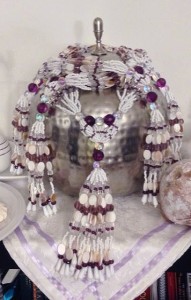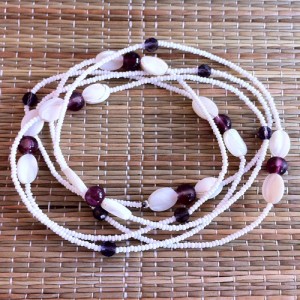-

Our church’s shrine for the orisha Obatala Obamoro.
Obatalá (also spells Obbatala or Obatala) is the eldest of the orishas in Santeria and king of the religion in orun (heaven). He is also the father of many of the orishas and as such is given great respect and deference by the other orishas in matters of great importance. He also acts as the “referee” or judge when the orishas have quarrels, working to restore and preserve peace at all times. To reflect his place of importance in the Lukumí pantheon, Obatala’s shrine is always placed higher than any other orisha in the home. Obatala is the owner of all heads, because it is said that he molded the bodies of humans before Olodumare breathed life into them. As such, Obatala protects all people, and acts as a guardian for those who do not yet know who their guardian orisha is.
- Obatala encourages us to be patient and to handle matters with calm and reason. His ashé (power) is perfectly embodied within his favorite color: white. He is always dressed in white and all of his offerings are white to reflect his spiritual purity and the coolness of his energy. White is our most sacred color in Santeria because it represents Obatala. When olorishas attend ceremonies we wear white clothing as holy vestments and to surround ourselves with Obatala’s protective energy. Iyawos (new initiates) in Santeria have to wear white clothing from head-to-toe for a year for the same reason: as a symbol of purity and as an energetic protection against osogbo.
- Obatala along with Oshun, Yemaya and Changó is one of the four pillar orishas that every olorisha receives at his kariocha initiation. Obatala is unique in that half of his roads are female and half are male. In that sense Obatala transcends gender, further demonstrating his ability to act impartially in orun (heaven) and with the orishas. If there is ever a debate about who a person’s guardian orisha is, they can safely be initiated with Obatala as he is the owner of all heads. Obatala is often depicted as elderly, with a full head of white hair, dressed in white robes.
Symbols, Numbers, Colors and Attributes of Obatalá

Obatala’s eleke is always made with white beads. This unique Obatala eleke has mother-of-pearl and purple beads added for the road Oba Moro.
Number: 8
Sacred Place in Nature: hills, mountains or high places
Color: White
Tools: A horsetail fly-whisk (some roads use a sword or cane)
Temperament: Calm, reasonable, quiet (some roads, like Ayáguna are youthful and fiery)
Syncretized Catholic Saint: Our Lady of Mercy or Jesus Christ
Obatalá’s Caminos (Avatars or “Roads”)
The name “Obatala” is actually a title of honor that means “King of the White Cloth (or caul)”, and there are many orishas that are called “obatala”. These various orishas are the roads of avatars of Obatala within Santeria. Here is a sample of Obatala’s roads:
Ayaguna – a male, fiery-tempered, warrior Obatala, who rides a horse and fights with a sword. He is said to resemble Chango’s behavior in many ways
Oba Moro – a male road of Obatala that is very old and requires quiet in the home. He doesn’t like being bothered or disturbed.
Obanlá – a vibrant, young, female Obatala that was wed to Ayaguna. She fights with a scimitar better than any other Obatala.
Ochalufón – an, old, wise, male Obatala who works at the right hand of Olofi. He taught mankind how to speak and the arts of the tongue.
Oshanlá – an old, female road of Obatala who was married to Oshagiyán. She likes to knit and sew in her rocking chair all day long.
Oshagiyán – also called Ochagriñán, this is an old, male road of Obatala who walks with a staff or two crutches, he is the father of Orunla.
Babá Achó – a young, male road of Obatala who gifted mankind with the seeds of the cotton plant, and the secrets of creating cotton cloth. His shrine is usually covered with different white cloths for this reason.
Offerings for Obatalá
Obatala eats a rather bland and restricted diet. He doesn’t like spicy foods, and salt is taboo for him. His offerings are always white or light in color. Obatala enjoys eating rice, eggs, coconut, cocoa butter, white yams, ñame and meringues. Obatala’s animal sacrifices include she-goat, hens, doves, and guinea hen. All of his animals for sacrifice must be white in color.
White Rice with Eggs for Obatalá
Cooked addimús are a wonderful offering for any of the orishas, but specifically for Obatala. When an person receives the odu (7-8) “edigbere” in a diloggun reading he is often told to act as “Obatala’s cook” – constantly offering cooked addimus for him. White rice with boiled eggs is one of the easiest cooked addimus to offer him. For this you’ll need some long-grain white rice and 4 white eggs. Simply cook the rice in the traditional manner making sure NOT TO USE ANY SALT when cooking the rice. Once the rice is done cooking, chop up some cocoa butter over the hot rice and stir it in so it melts and coats the grains of rice. Plate the rice in a tall mound or tower on a white plate. Boil the four eggs in a pot of water (NO SALT!) until they are hard-boiled: about 17 minutes time. Remove the eggs and submerge them in a bowl of cold water to completely cool them before peeling the shells off. Cut the four eggs lengthwise and arrange them around the edge of the mound of rice. Top the rice and eggs with a sprinkle of more cocoa butter and a powdering of cascarilla (powdered egg shell). Place the rice beside Obatala’s shrine for the proper amount of time then remove it and dispose of it in nature as dictated through divination.
Meringues for Obatalá
Another simple addimú you can make for Obatala is to go to a local bakery and purchase simple white meringue cookies. Stack these into a tower (as best you can) on a white plate and offer these to Obatala for the required amount of time as dictated by divination. Then the time has elapsed remove the meringues and dispose of them in nature in the appropriate place as determined through divination.

 Pagan Blog Project
Pagan Blog Project
Follow Us!